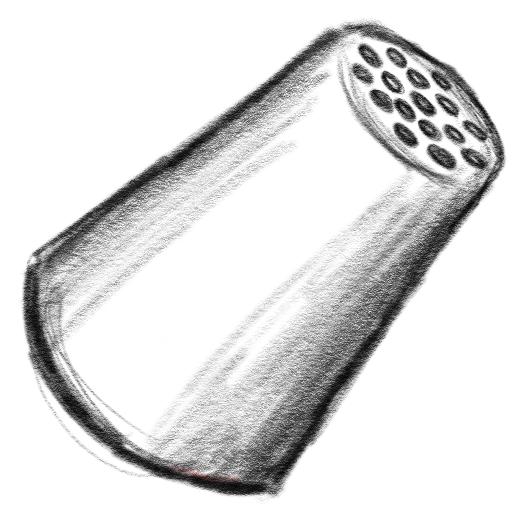
Open Coupler


Open Coupler

This was briefly touched on in the previous section, but the Open Coupler has plenty of uses in actual finished decorating. Using it makes a large, rounded shape, and is excellent for balloons, large daisy patterns, enthusiastic borders, or placing a blob of color for spatula work. For this, simply don't add any tips or the ring, and use as it is.
To use a tip in the coupler, fit the wide end of the metal shaped tip against the narrow end of the plastic coupler, and secure using the coupler ring. A functional setup should guide frosting through the shape that's attached, and not around the ring or edge of the bag. More on this later.


No. 2 Writing Tip

No. 2 Writing Tip
The No. 2 writing tip is so named because in Wilton products, the engraving and catalog number is a number 2.
This is the thinnest of the usable writing tips in most situations. It makes a very narrow line, and should only be used for small projects or very fine detail work. Trying to over-use this tip will very easily cause a frosting bag blowout from the level of needed pressure.
Best practical uses include writing on a cupcake or baby's smash cake, writing a second layer over the first layer of writing as a design choice, strings on a balloon for a cake that is for a relatively small gathering, or tiny details on a wedding or other very flowered cake.


No. 3 Writing Tip

No. 3 Writing Tip
The No. 3 writing tip is so named because in Wilton products, the engraving and catalog number is a number 3.
This tip is a fairly good catch-all for fine line work. It's good for flower or aesthetic curl detail, a reasonable writing width, or balloon strings on most birthday cakes. It carries significantly less risk of complete blowout with heavy use than a No. 2 tip, but more risk than a No. 4.


No. 4 Writing Tip

No. 4 Writing Tip
The No. 4 writing tip is so named because in Wilton products, the engraving and catalog number is a number 4.
This tip is the every-day common use tip for almost all writing and line work. It is small enough to handle cursive script, but large enough for said script to be seen across the room. With some force, it is reasonable at making polka-dot patterns; with less force it is delicate enough for balloon strings and detail marks. Everybody loves the No. 4 tip.


No. 7 Balloon Tip

No. 7 Balloon Tip
The No. 7 balloon tip is so named because in Wilton products, the engraving and catalog number is a number 7. Didn't we skip a few numbers? Yeah, probably. Don't worry about it, or go bother somebody else for how to use those. You don't need every tool for every hobby, and there really aren't that many use cases for sizes between 4 and 7 (or between 7 and 10, as we are about to learn), that aren't covered by adjusting pressure of the application.
As you may be able to tell from the name, this tip makes balloons... and also thick lines. It's good for putting that swag line around the edges of a cake, making a small bead-style border, bold polka-dots, or a quick version of certain uses of ribbon design without having to waste time switching to a ribbon tip in a high-speed situation. It's not actually that fabulous for balloons unless your balloons are very small.


No. 10 Balloon Tip

No. 10 Balloon Tip
The No. 10 balloon tip is so named because in Wilton products, the engraving and catalog number is a number 10. It's more or less like a No. 7 tip, but more so, and better for the same design on larger cakes.
As you may be able to tell from the name, this tip makes balloons... and also thick lines. It's also good for putting that swag line around the edges of a cake, making a bead-style border, bold polka-dots, or a quick version of certain uses of ribbon design without having to waste time switching to a ribbon tip in a high-speed situation. It's not actually that fabulous for balloons unless your balloons are relatively small, but can do in a pinch (though, really, just take the tip off?!).


Star Tips


Star Tips

Star tips are sometimes also known as Shell tips, and sometimes also known as some number or another in the Wilton catalog... the numbers stop now. We're into shapes.
These do come in different sizes, all the way up to larger than the coupler itself, intended to be used on cupcakes, but they all have the same thing in common: a number of sharp hills and valleys arranged evenly all the way around. When squeezed, they create a textured shape of frosting, sort of like the balloon tips in thickness. This shape is excellent for use as a border, to create quick little "star" shapes if held still and only squeezed briefly (thus the name), or to be applied in a swirl to create a rosette, which is a fine design by itself or can be passed off as a flower.


Quick Flower Tip

Quick Flower Tip
The quick flower tip is a bit of an odd creature. It's mostly only here because it's quite easy to mistake for a star tip, but with one major difference - the flower tip has a bead in the middle holding all of the spikes together, thus creating a ring of petal shapes instead of a textured balloon shape.
This creates a major difference in the stability of the extended usage; this tip is not suitable for borders or stars, and will only create a flower if held directly vertically and squeezed either straight up, or with a slight curl (more on this in the flower section). It is otherwise largely useless, and confusing to beginners and those not paying attention.


Rose Tip

Rose Tip
The rose tip, sometimes known as a ribbon tip, is a long and narrow shape that is slightly wider on one end, and pointed on the other. Its intended use is, as the name suggests, roses and ribbons. It's also good for stripes, rosebuds (which are noticeably different than roses), and getting a fairly flat section of color onto a cake to then spread out with a scraper or spatula.
For general usage, always keep the wider end of this tip facing down. It helps with the stability of the shape, providing a clean line if it's applied vertically.


Leaf Tip


Leaf Tip

The leaf tip comes in a few different forms. Most commonly used is the simple "v" shape, which creates a wide but flat output with a line up the center, and is fairly versatile for large or small uses. The "w" shape is wider and better for larger uses (leaves a messy finish if pulled up too short), and leaves a double-line up the center.
To use a leaf shape, put the wider, more cut-out section in a horizontal position, and the sharper section in a vertical position (to where you want the leaf; sometimes the leaf is pointing different directions). Use firm pressure to start off and build shape, and reduce pressure while pulling away to create the pointed tip.
Not all leaves are green! These also make great flower petals, autumn leaves come in plenty of colors, and the leaf-type shape is used in some specialty designs.


Basket Weave Tip

Basket Weave Tip
The basket weave tip is somewhere between a ribbon tip and a very small base icer. It is long and narrow, the same width all the way across, with a smooth side and a textured side.
When using this for a basket weave, the immediate thought is to put the texture on the outside. Do not do this. The texture is very easy to dent and make look bad, and it's what actually clings on to the base coat. Use it smooth side out, both for basket weaves and for creating flat-to-the-cake multipurpose ribbons.


Chrysanthemum Tip

Chrysanthemum Tip
The chrysanthemum, or just mum, tip, is an odd little thing. It's shaped like a "u", and is good for almost nothing besides making chrysanthemum flowers.


Grass Tip

Grass Tip
The grass tip is a flat-topped cylinder with several holes poked in it. Frosting from this tip comes out as a hairy clump, which isn't really great for a wide variety of uses, but does have a few functions. Grass, obviously. Pine needles. Fur on specialty items.

